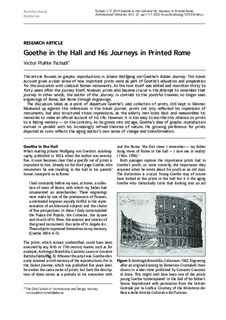| dc.description.abstract | The article focuses on graphic reproductions in Johann Wolfgang von Goethe’s Italian Journey. This travel account gives a clear sense of how important prints were as part of Goethe’s education and preparation for the encounter with classical Roman monuments. As the text itself was edited and rewritten thirty to forty years after the journey itself, however, prints also became crucial in the attempt to remember that journey. In other words, the author of the Journey, in contrast to the youthful traveler, no longer sees engravings of Rome, but Rome through engravings.
The discussion takes as a point of departure Goethe’s vast collection of prints, still kept in Weimar. Measured up against the references in the travel journal, prints not only reflected his impression of monuments, but also structured those impressions, as the elderly man looks back and reassembles his memories to make an official account of his life. However, it is too easy to ascribe this reliance on prints to a fading memory — on the contrary. As he grows into old age, Goethe’s idea of graphic reproduction evolves in parallel with his increasingly refined theories of nature. His growing preference for prints depicted as ruins reflects the aging author’s own sense of change and transformation. | nb_NO |
